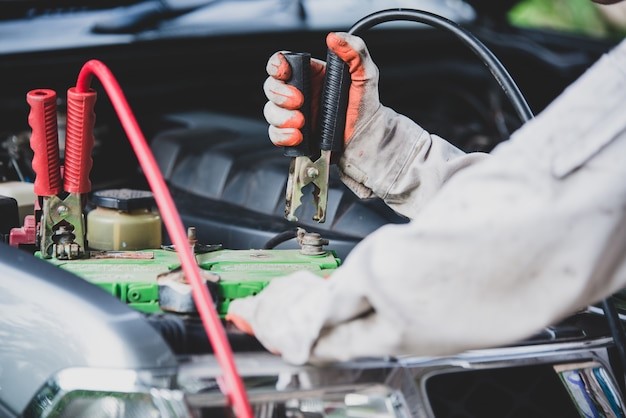Auto maintenance can be intimidating, especially if you haven’t spent a lot of time under the hood. But here’s a reality check: You don’t need to be a mechanic to perform one of the most important functions for your vehicle — checking the fluids. From engine oil to transmission fluid, these fluids help your car stay in shape and save you costly repairs. The process of checking them is not nearly as difficult as it sounds. Once you know where each reservoir is and what signs to look for, you’ll have that much more power to take good care of your car and to drive your car with assurance.
Why Car Fluid Checks Matter
The fluids in your car are like its blood, and they are the systems that maintain it. They reduce friction between parts, cool the engine, work with you to brake and make for a smooth steering experience. These fluids are what keep your car running, whenever you drive.
Failing to regularly check your fluid levels can result in a whole host of issues — overheating, poor handling, and even complete engine shutdown. Even worse, these are issues that often begin as small and become larger, expensive Car Repairs simply because the fluid level or condition was ignored.
The good news is that fluid checks are easy, cheap and usually need nothing more than a rag and a look. By becoming familiar with this process, you will safeguard your investment, be safer on the road and maybe even add thousands of miles to your car’s life.
The Essential Fluids You Should Check
Let’s begin by taking a look at the six vital fluids that you should check regularly. All serve different purposes in ensuring your car is safe and efficient.
Engine Oil
The engine oil is the most vital fluid in your car. It oils the engine’s moving parts, minimizing friction and cooling the parts down so they don’t succumb to heat. And clean oil is this nice thing to wash out some dirt and the little pieces of metal that are created in the engine, and help keep the engine clean from the inside.
Make sure that the oil level is neither too low, nor that the oil itself is dirty (in this case your engine must make much more effort). With time, that could cause it to seize up completely, causing catastrophic damage. That’s why it’s important to get in the habit of checking your engine oil regularly, particularly before long drives.
Coolant
Coolant Coolant, also known as antifreeze, is vital not just for preventing freezing, but also to keep your engine at the right temperature. It flows through the engine and absorbs heat, and then goes to the radiator, where it gives off heat.
Overheating is an engine’s worst enemy, and when you let your coolant level get too low, you risk this happening to your car. A coolant leak also can cause you to end up stranded on the side of the road, so checking your own antifreeze levels at certain intervals is important, especially if it’s very hot out or freezing.
Brake Fluid
Brake fluid carries the force of your foot on the brake pedal to the brake calipers that squeeze the pads against the rotors to make the car stop. It’s hydraulic fluid that needs to stay clean and at the proper level in order to work the right way.
Low brake fluid, or brake fluid contaminated by moisture, could result in spongy brakes, or no brakes at all. And being that the braking system is the vehicle’s single most important safety system, never neglect this inspection.
Transmission Fluid
Transmission fluid is what lubricates the gears inside your transmission and allows you to shift without all the grinding. It also serves as a coolant and hydraulic fluid in automatic transmissions.
Dirty or low transmission fluid can result in gears grinding and slipping, or shift delays. In the long run it can also damage the core components and be costly to Tire repair.
Power Steering Fluid
This liquid enables you to easily guide yourself by steering. Your steering wheel may be stiff and difficult to use if you don’t have the right amount in your car.
It also lubricates and protects the parts of your power steering system. If you hear whining sounds when turning, or you can’t steer at all, you could be low on fluid.
Windshield Washer Fluid
Windshield wash fluid is not the most glamorous thing, but visibility is a must for safe driving. Dirt, insects or road salt can obscure what you see.
This fluid also helps ensure your windshield wipers function as they should, so you don’t get those streaks that can obstruct your view, especially when it’s raining or snowing.
Tools for Checking Fluids
You don’t need a cool garage or special equipment to start. Here’s all you need:
Rags or paper towels: It is used for wiping dipsticks and cleaning drips.
Gloves: It helps to prevent chemical exposure to your skin.
A funnel: It for supplementing fluids without spilling them everywhere.
Your written guidebook: best resource for where the fluids are located and what type.
Once you have these basics, you’re ready to go.
Step-by-Step Guide to Checking Each Fluid
For your comfort let’s go over each fluid individually. Unless otherwise directed by your handbook always make sure the engine is cool and your car is parked on level ground.
Checking Engine Oil
Open the hood and find the oil dipstick. The (usually) bright handle (yellow, orange).
- Pull it off and wipe it down with a rag.
- Return the dipstick to its tube until it clicks in place.
- Pull it out again and look at the level of oil. It should be between the “Min” and “Max” lines.
- Observe the color and texture of the oil. Clean oil is amber. If it’s grimy, black, smells burned, change it.
Add oil only if you’re low, and use the type recommended in your owner’s manual.
Checking Coolant
- Locate the coolant reservoir it’s usually a clear plastic tank with level markings.
- Refer to the side of the tank to check if the coolant is between Low and Full.
- Never open the radiator cap when the engine is hot, or you could be sprayed with hot coolant.
- If the coolant is low, you can add a 50/50 mixture of antifreeze and distilled water, unless your owner’s manual states otherwise.
Checking Brake Fluid
- Find the brake fluid reservoir at the rear of the engine bay area.
- Check the fluid level by looking through the side of the reservoir: The level should fall between the “Min” and “Max” marks.
- Examine the fluid’s color. Brake fluid is normally clear or light amber. Dark or very cloudy fluid suggests that it’s time for a flush.
- Pro tip: Use only the correct brake fluid type — typically DOT 3 or DOT 4 or DOT 5 as recommended in your manual.
Checking Transmission Fluid
Not all vehicles have a transmission dipstick. A few may require a mechanic to inspect the fluid. If your car has a dipstick:
- Start the engine up and allow it to idle.
- With the parking brake applied, shift the transmission into Park.
- Clean it off, push it back in, then pull it out again.
- Inspect the fluid level and proper lubrication. Clean fluid should be pink or red colour with no burnt odour.
- If the fluid looks brown or smells burnt, it’s time to make an appointment to have your fluids changed.
Checking Power Steering Fluid
- Locate the “Power Steering” reservoir.
- Refer to the level markings on the side of the tank, or dip the stick in the cap.
- The solution should be clear to slightly amber. If it appears dark or foamy, it may be infected.
- Fill up with nothing but the specific fluid type recommended by your manufacturer.
Checking Windshield Washer Fluid
Find the washer reservoir it is generally identified by a symbol showing the windshield.
- Open the cap and look inside.
- It this fluid level is low, pour it with the washer fluid to the upper mark.
- Steer clear of plain water, which can freeze or attract bacteria.
Common Warning Signs of Low or Dirty Fluids
It’s not always necessary to wait for a dashboard warning light. Look (and listen) for these signs:
- Engine noise of knocking and ticking is a warning sign.
- Overheat or steam from under the hood (low coolant)
- Difficult or loud steering (if the power steering fluid is low)
- Brakes that feel spongy or unresponsive (low brake fluid)
- Bumping or jerking during gear change (not enough transmission fluid)
- Windshield cleaning not working well (no washer fluid)
She advises you to get your fluids checked out at the first sign of any of these.
When to Top Off vs. When to Call a Mechanic
Some fluid problems are a quick fix. Others require professional help. Here’s how to tell them apart:
Top Off Yourself When:
- The level is a tiny fraction low NaCl solution.
- The fluid appears clean and the smell is normal.
- You don’t see visible leaks.
Call a Professional Mechanic If:
- Fluid levels drop repeatedly.
- Puddles form under your car.
- The fluid is dark, gritty or smells burned.
- You don’t know what type of liquid to serve.
Don’t ignore consistently low fluids—it’s a sign of a leak or mechanical problem.
Conclusion
This is a cheap, easy way to take care of your vehicle. It takes only a few minutes once you know where everything is.” These easy little jobs can save you from breakdowns, improve your safety, and save you hundreds if not thousands of dollars in potential repairs down the line.
Get into the habit of checking your fluids out monthly. And if in doubt, check your owner’s manual or go to a professional mechanic. Your car — and your wallet — will appreciate it.
FAQs
Engine oil and coolant levels should be examined once per month. Brake, transmission and power steering fluid: These liquids can be checked every couple of months or during oil changes.
Always follow the specific guidelines in your owner’s manual. Many late model cars and trucks have particular brand favorites they like to see in their power steering systems and using the wrong fluid could damage parts and void your warranty.




